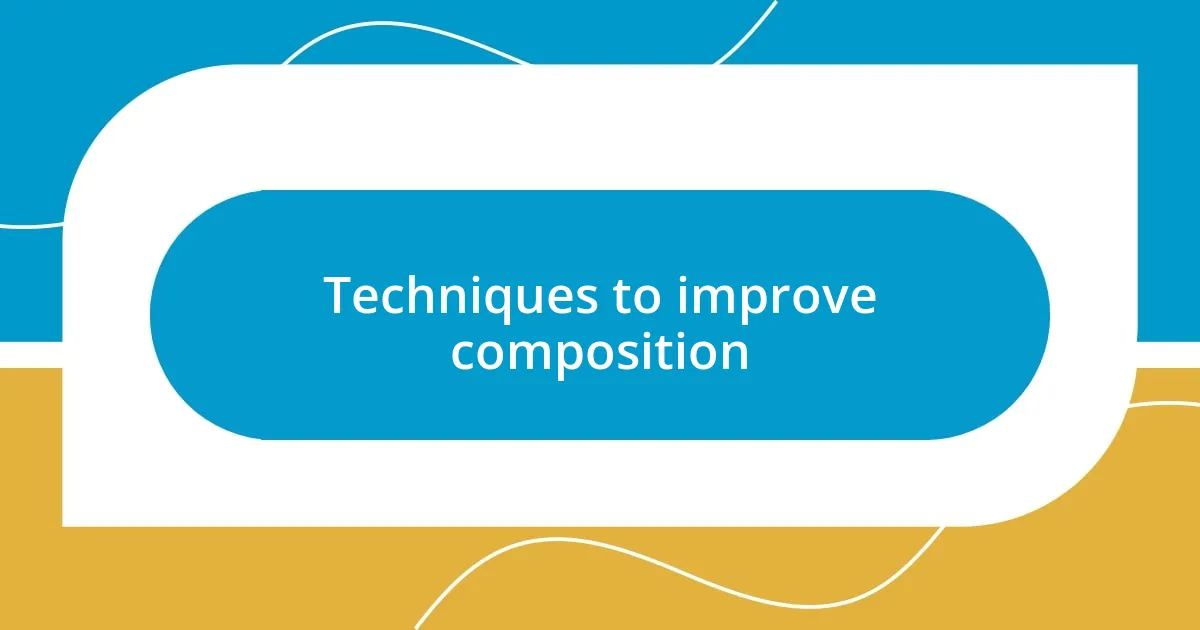Key takeaways:
- Unpredictable weather can create both challenges and unique photographic opportunities; being prepared and adaptable is key.
- Preparation, including weather checks and location scouting, is vital for successful landscape photography.
- Utilizing composition techniques like the rule of thirds, leading lines, and foreground interest can significantly enhance image quality.
- Post-processing techniques, such as graduated filters and noise reduction, can transform raw photos into captivating pieces of art.

Identifying landscape photography challenges
One of the first hurdles that many landscape photographers face is the unpredictability of weather. I remember a time when I trekked out to capture the sunrise over a breathtaking valley, only to be greeted by thick fog that rendered the scene almost invisible. It left me wondering, how often have I let less-than-perfect conditions deter me from exploring?
Another challenge is finding the right composition in a bustling scene. There have been countless moments when I’ve stood in awe of a majestic landscape only to feel overwhelmed by where to point my camera. This brings about the question: how do you distill all that beauty into a single frame? I’ve often had to remind myself to take a step back, breathe, and allow the scene’s elements to reveal their story.
Lighting plays a pivotal role in landscape photography, and recognizing the right time to shoot can be daunting. I vividly recall one evening at a coastal cliff, where the golden hour light transformed the landscape into a painter’s palette. But without that perfect timing, it could easily have been just another average shot. So, I ask you—how much effort do you invest in scouting your locations at different times? Understanding and embracing these challenges can truly elevate your craft.

Understanding the importance of preparation
Preparation in landscape photography is crucial; it can make or break your experience. I’ve learned this firsthand after finding myself unprepared on multiple occasions. One time, I headed out to a remote mountain area without checking the weather forecast. The subsequent downpour not only soaked my gear but left me feeling incredibly frustrated, teaching me that a little preparation could save a lot of heartache.
When I reflect on my most successful photography trips, I always come back to my planning routine. I usually scout locations online, studying various angles and compositions. I recall a trip to a national park where, armed with my research, I was able to capture a unique viewpoint at sunrise. Without that extra effort, I would have missed a once-in-a-lifetime shot, reinforcing how vital preparation is to achieving my artistic vision.
Additionally, good preparation includes knowing your camera settings and local regulations. I once ventured into a protected area, only to be stopped by a park ranger who informed me that I was in a no-shoot zone. It was embarrassing, but more importantly, it was a reminder that understanding local rules is just as important as preparing technically. Being prepared allows for creativity to flourish rather than being hindered by avoidable obstacles.
| Type of Preparation | Personal Experience |
|---|---|
| Weather Check | Facing unexpected rain during a shoot taught me the importance of checking forecasts. |
| Scouting Locations | Researching viewpoints helped me capture a stunning sunrise at a national park. |
| Understanding Regulations | Getting stopped by a park ranger reminded me to know local shooting guidelines. |

Techniques to improve composition
When it comes to improving composition, I’ve discovered that using the rule of thirds can fundamentally change the way I approach a scene. Instead of placing my subject dead center, I envision a tic-tac-toe grid overlaying my viewfinder. This method naturally directs the viewer’s eye to points of interest and creates a more dynamic image. I remember a sunset shoot where I positioned the sun on one of the intersecting points, resulting in a striking balance between the sky and the foreground.
Here are some techniques that have worked wonders for me:
- Leading Lines: I often look for natural lines, like paths or rivers, that draw the viewer into the scene. They create depth and guide the eye toward the main subject.
- Framing: I like to use foreground elements, like trees or rock formations, to frame my subject. This can make the image feel more immersive and grounded.
- Foreground Interest: Including elements in the foreground adds depth. On a recent shoot, a patch of vibrant wildflowers in the foreground elevated an otherwise flat landscape shot.
- Symmetry and Patterns: I’ve found that symmetry can be captivating. Reflective waters or mirrored landscapes can create a sense of harmony that’s visually appealing.
Additionally, I often experiment with different perspectives. Getting low to the ground or finding an elevated viewpoint can drastically change the composition. On one memorable occasion, I climbed up a small hill to photograph a lake, and I was rewarded with a stunning vista that transformed my image from ordinary to breathtaking. Exploring these creative techniques has truly empowered me to capture the essence of my surroundings in a way that resonates with both me and my audience.

Dealing with unpredictable weather
Dealing with unpredictable weather in landscape photography can be both a challenge and an opportunity. I once found myself on a cliff edge during a sudden gust of wind and unexpected rainfall, leaving me drenched but oddly exhilarated. The stormy clouds created a brooding atmosphere that transformed the landscape into something magical when I managed to capture it. It made me realize that sometimes, the most dramatic shots arise from chaos.
I also learned to embrace the changing conditions. On one chilly morning, I ventured out despite gray skies, convinced it would ruin my chances for a good photo. Yet, as the sun peeked through the clouds, it illuminated the landscape in a way that I could have never anticipated. The soft, diffused light not only enriched the colors but also added depth to my images. It got me thinking: do we sometimes dismiss potential beauty too early because of fear of the weather?
Equipping myself with the right gear has been instrumental in turning these unpredictable situations in my favor. I’ve invested in weather-sealed equipment and always kept a sturdy rain cover on hand. On a particularly rainy hike, this preparation allowed me to snap a series of shots while the rain blurred the background, resulting in a dreamy, impressionistic effect. It’s these experiences that reaffirm my belief that anticipating weather changes isn’t just about coping; it’s about seizing moments that others may overlook.

Mastering equipment for best results
Mastering my equipment has been crucial in getting those perfect landscape shots. When I first started, I was overwhelmed by the different settings on my camera. I remember standing on a breathtaking mountain overlook, fiddling with the aperture and exposure, realizing too late that I missed a stunning moment. It hit me then: knowing your gear inside and out isn’t just technical; it’s intimately tied to how you perceive a scene. Do you really want to let the magic of the moment slip away while you’re still figuring out shutter speeds?
Over time, I’ve learned to embrace hands-on practice. During one memorable outing, I decided to leave my tripod at home, thinking I’d just rely on stability and natural light. It turned out to be a transformative experience. I had to adapt, which forced me to master handheld shots and experiment with higher ISO settings. I ended up capturing a dramatic sunrise that I wouldn’t have otherwise achieved. That morning taught me that sometimes, abandoning the safety of my usual tools spurs creativity and sharpens my skills.
I also discovered the beauty and necessity of familiarity with accessories. For instance, I remember investing in a quality polarizing filter, something I initially thought was just a nice-to-have. Its ability to reduce glare and enhance colors was a game changer during a photo session by the lake. That vibrant reflection on the water transformed into something ethereal. It made me wonder: how many photographers overlook the potential of simple accessories? The right gear can elevate your photography, shifting your work from ordinary to extraordinary if you’re willing to learn and experiment with it.

Post-processing tips for enhancing images
After capturing that stunning landscape, I found post-processing to be an invaluable ally in refining my images. I remember sitting at my computer, feeling a mix of excitement and hesitation as I opened that breathtaking shot from my morning hike. There’s something magical about bringing out the colors and contrasts that may not be fully visible in the raw photo. By adjusting the saturation and playing with highlights and shadows, I often realize just how much potential lies within each shot. Doesn’t it feel rewarding to transform an already beautiful image into something even more captivating?
One technique I’ve found particularly useful is utilizing graduated filters in software like Lightroom. I once had a photo with an incredible sunset, but the foreground was hopelessly dark. By applying a subtle graduated filter, I was able to brighten the lower part of the image without disturbing the drama of the sky. The moment I saw the transformation, I felt a surge of inspiration. This tool allowed me to balance the elements in my composition seamlessly. Why settle for less when you can create harmony in your images with just a few adjustments?
Lastly, I can’t stress enough the impact of sharpening and noise reduction during post-processing. After returning from a trip to the mountains, I felt frustrated with some grainy shots due to the low-light conditions. However, by carefully applying noise reduction to maintain the image’s integrity, I was amazed to see the image restored to a level where it still felt true to the moment. Isn’t it remarkable how a little editing can turn an imperfect situation into a striking piece of art? These post-processing tips have not only enhanced my images but also deepened my appreciation for the craft.

Sharing experiences to inspire others
Sharing my experiences in landscape photography has always been a way for me to connect with others. I remember the first time I attended a local photography meet-up, where I shared my story of missing a sunset because I didn’t trust my instincts. My vulnerability struck a chord, and others began sharing their own struggles. It felt rewarding to realize that our challenges were universal—we all hesitated at times or let moments slip through our fingers. Isn’t it amazing how sharing our difficulties can turn into a source of inspiration for others?
Moreover, I vividly recall posting a before-and-after comparison of a poorly edited shot on social media. I was apprehensive at first but decided to be transparent about my journey in mastering editing software. The flood of messages from photographers who felt encouraged to embrace their editing struggles was overwhelming. Many reached out to share how they’d faced similar challenges, and it became a powerful reminder that we can uplift one another through authenticity. What if we all embraced our learning curves instead of hiding them?
Finally, I often give talks at local photography clubs, where I highlight not just my successes but also the stumbles along the way. One time, while discussing how I learned to embrace unexpected weather changes during shoots, a member approached me, eager to learn how to adapt to the unpredictable. It was fulfilling to share practical strategies, like keeping extra layers and diverse camera settings handy. I’ve found that these discussions ignite enthusiasm—when I’m candid about my challenges, it seems to spark a desire in others to push their own boundaries. What are the stories you could share that might inspire someone else?














